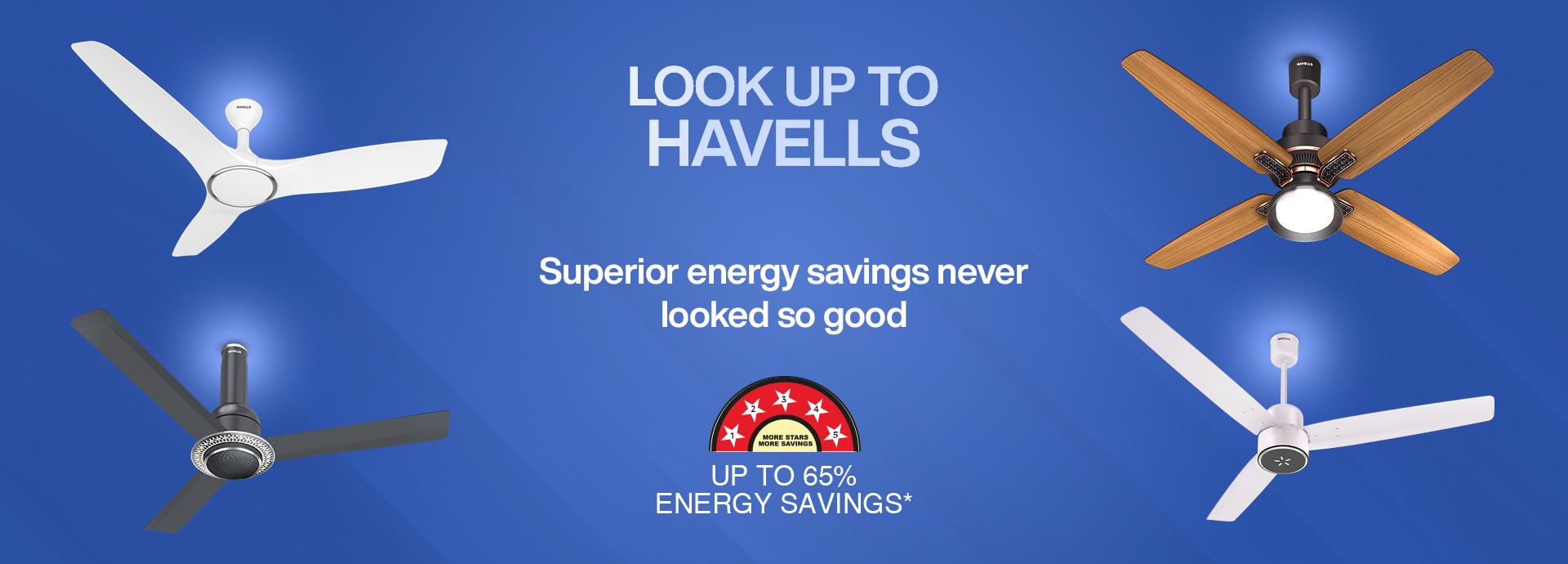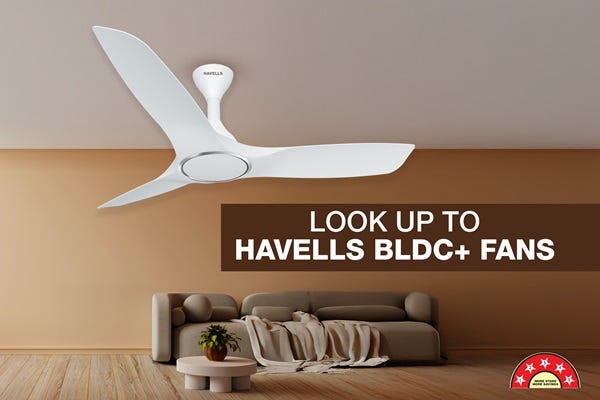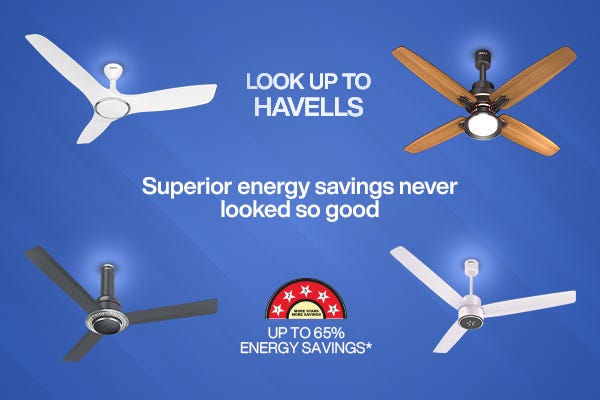How to Choose the Best Ceiling Fan for Your Home: A Complete BLDC Fan Buying Guide

How to Choose the Best Ceiling Fan for Your Home: A Complete BLDC Fan Buying Guide
With countless ceiling fan options available—varying in design, size, features, and price—choosing the right one for your home can feel overwhelming. While aesthetics and cost are often top priorities, a ceiling fan is much more than just a decorative fixture. It plays a crucial role in maintaining comfort, ensuring proper air circulation, and improving energy efficiency.
If you're looking for a fan that not only cools your space but also enhances energy savings, BLDC (Brushless Direct Current) ceiling fans are a game-changer. This modern technology is transforming the way we think about ceiling fans, offering superior performance, energy savings, and quieter operation. In this guide, we'll walk you through everything you need to know about choosing the perfect BLDC ceiling fan—from key features and energy efficiency to design choices and the latest innovations.
Motor Technology: Embracing BLDC Fans
The motor is the heart of a ceiling fan, influencing its efficiency, noise level, and longevity. Traditional fans use AC (Alternating Current) motors, which are less efficient and noisier. In contrast, BLDC (Brushless Direct Current) motors offer several advantages:
- Energy Efficiency: BLDC motors consume significantly less power, reducing electricity bills.
- Quiet Operation: The absence of brushes results in minimal noise, enhancing comfort.
- Durability: Fewer moving parts lead to reduced wear and tear, extending the fan's lifespan.
- Smart Features: Many BLDC fans come equipped with remote controls and compatibility with smart home systems.
Understanding Room Size and Fan Sweep
The effectiveness of a ceiling fan largely depends on its size in relation to the room. The sweep size (total diameter when the fan is in motion) determines how much air the fan can circulate. Selecting an appropriately sized fan ensures optimal airflow and energy efficiency.
Standard Sweep Sizes
- 600 mm : Suitable for very small spaces of approx 1.2 m x 2 m, such as verandah, utility, small cabins, bathrooms or pantries.
- 900 mm : Best for rooms of approximately 3 m x 3 m, such as guest bedrooms, drawing rooms etc.
- 1200 mm : Appropriate for rooms between 3.6 m x 4 m, such as master bedrooms, living rooms or dining halls.
- 1400 mm : Designed for bigger rooms of 4.2 m x 4.8 m, like larger halls and workspaces.
Installing multiple fans may be necessary for larger or elongated rooms to ensure even air distribution.
Ceiling Height and Mounting Options
The height and design of your ceiling influence the type of fan mounting required for both safety and performance.
- Flush Mount: Ideal for ceilings less than 2.43 m high, this mounting keeps the fan close to the ceiling, ensuring adequate headroom.
- Downrod Mount: Suitable for ceilings 2.74 m or higher, downrods lower the fan to an optimal height for effective airflow.
- Angled Mount: Designed for sloped or vaulted ceilings, this mount ensures the fan hangs correctly and operates efficiently.
Energy Efficiency and Air Delivery
When selecting a ceiling fan, two critical factors to evaluate are energy efficiency and air delivery. A well-designed fan should provide powerful airflow while consuming minimal electricity, ensuring both comfort and cost savings.
- Wattage and Power Consumption: Fans with lower wattage ratings consume less electricity, reducing energy costs over time. BLDC (Brushless Direct Current) fans are particularly energy-efficient, typically operating at around 32 W, whereas conventional fans often consume 50 W or more.
- Air Delivery (CMM - Cubic Meters per Minute): A fan’s air delivery capacity determines how effectively it circulates air in a room. Higher CMM ratings indicate better airflow and cooling, ensuring consistent comfort across the space.
Havells Elio Prime delivers superior performance with sleek aesthetics
The Havells Elio Prime fan is an excellent choice for those seeking maximum efficiency and enhanced aesthetics without compromising performance. It combines low power consumption with superior air delivery, making it a smart investment for energy-conscious homeowners.
Smart Features and Controls
Ceiling fans have evolved beyond basic functionality, now integrating smart technologies that offer greater convenience and customization. These advanced features allow users to control their fans effortlessly, improving both comfort and energy efficiency.
- Remote Control: Adjust speed, turn the fan on or off, and switch modes without needing a wall switch, providing hassle-free operation.
- Smartphone Integration: With dedicated mobile apps, users can schedule operations, set timers, and control fan speed remotely, ensuring optimal cooling even before entering the room.
- Direct Voice Command : Havells Stealth Air Voice Fan comes with AI powered Direct Voice Command which does not require wifi, blue tooth or Smart Phone, thus making smart home integration seamless. Just Talk to your fan.
For those looking to embrace smart living, Havells’ Stealth Voice fan offers effortless management with just a simple command.
Design Aesthetics
When choosing a ceiling fan, its design should not only serve a functional purpose but also complement your home’s overall aesthetic. A well-designed fan can seamlessly blend into your interior or even become a focal point that elevates the visual appeal of your space. With a wide variety of styles, finishes, and colors available, selecting the right fan ensures that it enhances both the ambiance and comfort of your home.
● Modern Designs: Minimalist and Smart Technology
For homes with a contemporary aesthetic, sleek and minimalist ceiling fans with smart features are the perfect choice. These fans often feature streamlined blades, matte or metallic finishes, and neutral color palettes that blend effortlessly with modern interiors. Models like the Havells Stealth Voice embody this trend with their Direct Voice Command cutting-edge technology, making them ideal for urban apartments and modern living spaces.
Havells Stealth Air combines minimalist design with smart controls
● Traditional Styles: Timeless and Ornate Craftsmanship
For those who prefer a more classic or vintage look, ceiling fans with ornate details, intricate patterns, and wooden-finish blades offer an elegant touch. These fans are designed to complement heritage homes, colonial-style interiors, or spaces with rich wooden furnishings. The Havells Albus, with its premium reversible wood-finish blades and ‘Reverse Rotation’ feature for circulating warm air in winter, is an excellent example, adding warmth and sophistication to spaces that embrace traditional décor.
● Color Options: Making a Statement or Blending Seamlessly
The color of your ceiling fan plays a crucial role in either complementing your décor or making a bold style statement. Neutral tones like white, beige, or matte black work well in most interiors, offering a subtle yet sophisticated look. On the other hand, bold and vibrant colors such as deep browns, rich blues, or metallic gold accents can turn a ceiling fan into a decorative centerpiece. Choosing the right shade ensures harmony with the room’s furniture, wall colors, and overall design theme.
Noise Levels and Build Quality
A ceiling fan should provide comfortable airflow without creating unnecessary noise, especially in spaces like bedrooms, study areas, and home offices where a peaceful environment is essential. Let us explore some factors that contribute to the noise levels of ceiling fans.
● Motor Type: The Key to Noise Reduction
The motor is the heart of a ceiling fan, and its technology plays a crucial role in determining noise levels. BLDC (Brushless Direct Current) motors are known for their silent operation compared to traditional AC motors. Unlike AC motors, which rely on friction-based components that can cause humming or rattling noises over time, BLDC motors use electronic commutation, reducing both mechanical wear and sound output.
● Blade Design
A fan's blade structure and aerodynamics influence how smoothly air is circulated. Aerodynamically designed blades minimize air resistance, leading to a quieter and more efficient operation.
● Construction Quality
The materials and build quality of a ceiling fan determine its longevity and noise output. Fans constructed with high-quality bearings, durable housing, and well-balanced components experience less vibration and produce lower noise levels.
For those seeking technology at its best with ultra-quiet performance, the Havells Stealth Voice fan is a game-changer. Designed with advanced BLDC technology, aerodynamically optimized blades, and precision-engineered components, it ensures whisper-quiet operation without compromising on airflow.
Conclusion
Choosing the right ceiling fan requires considering factors beyond aesthetics and price. By evaluating room size, motor technology, energy efficiency, smart features, and noise levels, you can find a fan that provides optimal comfort, style, and savings.
Havells' latest range of ceiling fans - including Cerra, Epic Signia, Stealth Voice, and Albus, offer cutting-edge technology, high performance, and elegant designs, catering to a variety of preferences and home styles.
Ready to upgrade your home with the perfect ceiling fan? Explore the Havells collection now!
Author Bio: Shivanie Khanka is a passionate architect and designer hailing from Uttarakhand. She is constantly drawn to the evolving world of design and gleans inspiration from diverse sources like books, films, and art that fuel her creative fire.
















